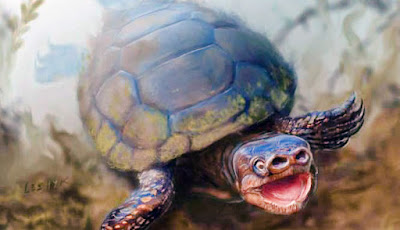A new species of baenid turtle from the Kaiparowits Formation (Upper Cretaceous: Campanian) of southern Utah. Lively, J.R. 2015. Journal of Vertebrate Paleontology.
An artist's depiction of the turtle Arvinachelys goldeni as it would have appeared in life 76 milion years ago in southern Utah. Credit: Victor Leshyk
The pig-nosed turtle's scientific name derives from arvina, a Latin word for pig fat or bacon¬, and chelys, Latin for tortoise. And goldeni honors Jerry Golden, a volunteer fossil preparator at the Natural History Museum of Utah, who prepared the new holotype specimen—and many others in the museum's collections.
"Volunteers are involved in every aspect of what we do, from field work and digging up specimens to preparing them," said Randall Irmis, curator of paleontology at the museum and associate professor at the University of Utah. "In 2014, volunteers provided 14,500 hours of work. It's a massive contribution. We couldn't do what we do without them. We really consider them key team members. From: Phys Org.
